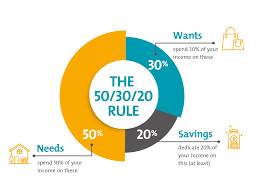The 50/30/20 Rule: A Simple Approach to Budgeting
Budgeting doesn’t have to be complicated. The 50/30/20 rule offers a simple yet effective framework for managing your finances, making it easier to prioritize your spending, saving, and financial goals. This rule divides your after-tax income into three categories: 50% for needs, 30% for wants, and 20% for savings and debt repayment. Let’s break down how it works and how you can apply it to your financial life.
1. The Basics of the 50/30/20 Rule
The 50/30/20 rule was popularized by Senator Elizabeth Warren in her book All Your Worth: The Ultimate Lifetime Money Plan. It’s designed to provide a balanced approach to budgeting that’s easy to understand and apply. Here’s how the rule divides your income:
50% for Needs:
This portion covers essential expenses that are necessary for day-to-day living. These include:
Rent or mortgage payments
Utility bills (electricity, water, gas)
Groceries
Insurance (health, car, home)
Transportation costs (car payments, public transit)
Minimum loan payments (debt obligations)
30% for Wants:
The wants category includes non-essential items that enhance your lifestyle but aren’t required for basic survival. Examples include:
Dining out and entertainment (movies, concerts)
Travel and vacations
Shopping for clothes, gadgets, and hobbies
Subscriptions (streaming services, gym memberships)
20% for Savings and Debt Repayment:
The final 20% goes toward building your financial future, which includes:
Contributions to savings accounts or emergency funds
Retirement contributions (401(k), IRA)
Paying down debt (extra payments on loans, credit card balances)
This structure helps ensure you cover your essential needs, enjoy some flexibility with your wants, and still prioritize long-term financial health.
2. Applying the 50/30/20 Rule to Your Budget
To implement the 50/30/20 rule, follow these steps:
Step 1: Calculate Your After-Tax Income
Start by determining your monthly after-tax income. This is the money you take home after taxes, deductions, and any employer-sponsored contributions (like retirement). If you’re self-employed, subtract estimated taxes from your gross income.
Example:
If you earn $4,000 per month after taxes, your budget under the 50/30/20 rule would look like this:
$2,000 (50%) for needs
$1,200 (30%) for wants
$800 (20%) for savings and debt repayment
Step 2: Categorize Your Expenses
Next, list all your expenses and categorize them as either needs, wants, or savings. Be honest with yourself when sorting expenses—while some bills may feel like needs, they might actually belong in the wants category (like premium cable or dining out).
Step 3: Adjust as Needed
If your current spending doesn’t align with the 50/30/20 breakdown, don’t worry! The goal is to use the rule as a guide to find balance. If, for example, your needs exceed 50% of your income, you may need to cut back on wants or find ways to reduce necessary costs (like downsizing your home or shopping for cheaper insurance).
Alternatively, if you’re putting more than 30% of your budget toward wants, you may need to reassess your priorities to free up more money for savings or debt repayment.
3. The Benefits of the 50/30/20 Rule
The 50/30/20 rule is popular because it’s simple, flexible, and easy to follow. Here are a few benefits of using this method:
Simplicity:
The rule gives you a clear framework without the need for complex budgeting tools or detailed expense tracking. It’s easy to remember and apply, especially for those new to budgeting.
Balance:
By allocating 30% of your income to wants, the rule acknowledges the importance of enjoying life while still prioritizing financial goals. It strikes a balance between living in the moment and planning for the future.
Flexibility:
The rule can be adjusted to fit different financial situations. For example, if you have significant debt to pay off, you might temporarily allocate more than 20% to debt repayment. Similarly, if your needs take up more than 50%, the rule can help you identify where you can make adjustments to free up funds for savings.
4. Potential Challenges and How to Overcome Them
While the 50/30/20 rule is straightforward, it might not be a perfect fit for everyone. Here are some challenges you may encounter:
High Cost of Living:
If you live in an area with a high cost of living, your needs may take up more than 50% of your income. In this case, you might need to reduce your wants or adjust the percentages to fit your situation. Focus on keeping your savings goals intact, even if it means sacrificing more in the wants category.
Fluctuating Income:
For freelancers or those with irregular income, sticking to fixed percentages can be tricky. In this case, it may be helpful to use an average monthly income based on your earnings over the past year. You can also adjust your budget on a month-to-month basis, contributing more to savings in higher-income months.
5. Long-Term Financial Health
While the 50/30/20 rule provides a simple framework for day-to-day budgeting, it also promotes long-term financial health. By consistently saving 20% of your income, you’ll build an emergency fund, work toward financial independence, and create a safety net for unexpected expenses. It encourages disciplined saving and helps you avoid overspending on non-essentials.


